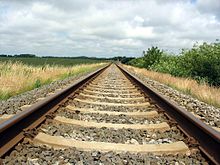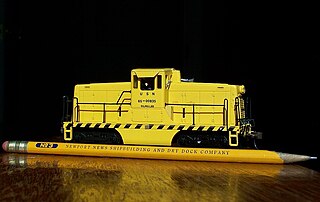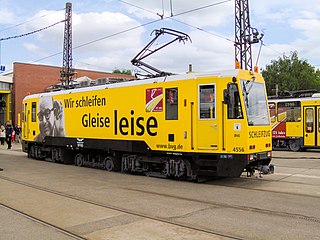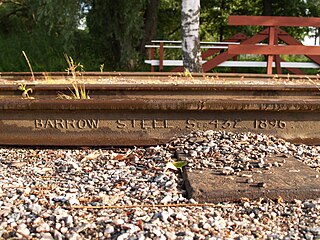

A concrete sleeper (British English) or concrete tie (American English) is a type of railway sleeper or railroad tie made out of steel reinforced concrete.


A concrete sleeper (British English) or concrete tie (American English) is a type of railway sleeper or railroad tie made out of steel reinforced concrete.
In 1877, Joseph Monier, a French gardener, suggested that concrete reinforced with steel could be used for making sleepers for railway track. Monier designed a sleeper and obtained a patent for it, but it was not successful.[ citation needed ]
Concrete sleepers were first used on the Alford and Sutton Tramway in 1884. Their first use on a main line railway was by the Reading Company in America in 1896, as recorded by AREA Proceedings at the time. Designs were further developed and the railways of Austria and Italy used the first concrete sleepers around the turn of the 20th century. This was closely followed by other European railways.[ citation needed ]
Major progress was not achieved until World War II, when the timbers used for sleepers were scarce due to competition from other uses, such as mines. [1] Following research carried out on French and other European railways, the modern pre-stressed concrete sleeper was developed. Heavier rail sections and long welded rails were also being installed, requiring higher-quality sleepers. These conditions spurred the development of concrete sleepers in France, Germany and Britain, where the technology was perfected.[ citation needed ]
The 1 ft 11+1⁄2 in (597 mm) gauge Lynton and Barnstaple Railway (1898 to 1935) in North Devon, experimented with concrete sleepers at a number of locations along the line. As the sleepers were cast to gauge, they were of little use outside the station areas on this very curvaceous line where gauge slackening was commonly required. They were also noisy and lacked the elasticity of wooden sleepers creating a very rigid road. [2] Some of those concrete sleepers can now be seen on display at Woody Bay Station. [3]
Interest in concrete railway sleepers increased after World War II following advances in the design, quality and production of pre-stressed concrete.
Chaired bullhead concrete sleepers have been around since at least the 1940s; the Great Western using a two-holed chair, thus saving both scarce wartime timber and steel fixing bolts. [4] This design was used by the government-run railways during World War II and in particular immediately prior to D-Day when timber was scarce and track extension or replacement was urgently required. Gravesend West Street station was thus relaid in 1944 to enable the huge increase in freight to be handled.[ citation needed ]
In 2021, sleepers made of sulphur concrete, which requires low energy and no water in manufacture, were used in Belgium. [5]

Concrete sleepers can be one piece of uniform or variable dimensions. They can also consist of two separate blocks connected by a steel tie rod. Again, the Great Western Railway during World War Two produced chaired "pot" type sleepers — two concrete pods connected by steel bars — for use on sidings and some loops but these monoblock pot sleepers did not carry a gauge-tie at every position, such usually being placed every 3 or 4 pots or successively at rail joints. Such an example was recorded in a siding at Talyllyn East Junction and at Rock Siding, Talybont-on Usk, on the former Brecon & Merthyr Railway in September 1963. Until quite recently, examples were to be seen at Dovey Junction on the Cambrian Coast and others may still exist elsewhere. [6]
Exceptionally, the concrete can be poured as two separate longitudinal slabs, as has been used in Namibia. Slab track consists of a continuous concrete roadbed without division into separate sleepers, and these are most often used in tunnels. British Rail experimented with slabs during the late 1960s and laid several miles alongside the main running lines north of Derby.[ citation needed ]
Concrete sleepers lack the elasticity of wooden sleepers and, therefore, ballast tracks with concrete sleepers usually have a much quicker degradation of the ballast when loaded. This is especially true in curves, turnouts and switches. To reduce the wear on the ballast, and in some cases offer vibration isolation, pads are fitted to the base of the sleeper. The pads are usually manufactured of polyurethane foams with a stiffness tailored to meet the elasticity requirements of the track.[ citation needed ]
To reduce degradation of the ballast, a very stiff semi-plastic polyurethane foam can be used that mimics the plastic behaviour of wooden sleepers; the ballast stones are pressed into the surface of the sleeper, increasing contact area. Typically, these pads are 7 mm (0.28 in) to 10 mm (0.39 in) thick. In order to achieve vibration isolation as well, the elastic layer needs to be softer, and in many cases thicker. A vibration isolation of 5-12 dB can be achieved, but the results will depend on many factors, such as axle load, velocity, subsoil stiffness, ballast thickness, ballast quality and more. Therefore, it is very difficult to predict the results exactly.[ citation needed ]
Despite concrete sleepers being less elastic than timber ones, it has been established that they do not cause higher noise emissions when trains run over them. A study undertaken as part of Euronoise 2018 found that concrete sleepers are on average 2 dB(A) quieter than wooden sleepers, but on straight sections of track cause more noise emissions in the sub-bass (16–60 Hz) and midrange (500–2000 Hz) frequencies ranges. Although wooden sleepers cause more noise emissions nearly universally across the audible frequency range on curved sections of track, the sharper acoustic response of concrete sleepers on straight track may cause a subjective perception that concrete sleepers are more noisy. [7]

Advantages include: They do not rot like timber sleepers, are fire proof, their extra weight makes track more stable (particularly with changes in temperature), they can withstand fire hazards better than wooden sleepers, they give more retentivity to the track, they have a longer life than wooden sleepers, and they need less maintenance, resulting in lower ongoing costs and fewer track closures. Additionally, concrete sleepers are not soaked in creosote like most wooden sleepers (used mainly in Europe), therefore they are environmentally friendlier.

Disadvantages include: When trains derail and the wheels hit the sleepers, timber sleepers tend to absorb the blow and remain intact, while concrete sleepers tend to shatter and have to be replaced. Initial costs are greater, and they are unsuitable for change of gauge, unless this is already taken into account. Concrete sleepers are up to 300 pounds (136.1 kg) heavier than their wooden counterparts. As a result, larger sized ballast is required to both support and hold in place the sleepers on the roadbed. Additionally, they do not absorb as much vibration from passing trains as wooden sleepers do. This can cause degradation of the sleepers themselves ranging from small cracks to complete failure over time. This problem is most prevalent when the sleepers are located next to joints in the rails. For this reason, railroads which used concrete sleepers for plain line avoided them on turnouts and interlockings; however, modern designs allow use of concrete bearers for turnouts and they have become standard for switch renewals on many railways. Another potential fault is lateral rigidity which may cause cumulative metal fatigue, particularly on reverse curves where the stresses are accentuated by the abrupt change of lateral forces. This in turn may be the cause of gauge corner cracking in the rails themselves as well as the steel sleeper reinforcement.
German railways have experienced cracking of their sleepers on high speed lines and have had to replace many thousands of them after only a short life; however, this was found to be due to use of inappropriate aggregate in the concrete mix. [8] Damaged concrete sleepers cannot be repaired. Old concrete sleepers can be used for things like retaining walls, else they might be crushed to recycle gravel and the steel reinforcing. [9]
Special sleepers may be necessary on extremely sharp curves, such as the new triangle at Newmarket, New Zealand on the 1,067 mm (3 ft 6 in) gauge of radius 95 m (312 ft). Here the sleepers are extra heavy, about 250 kg, and may include gauge widening with transitional gauge widening. [10]
Concrete sleepers for turnouts must be individually custom designed for the location. They are much longer than normal sleepers, have gaps for switch motors, and are generally made by a small number of specialist manufacturers. If a turnout is needed in a hurry, it may be made with timber sleepers which can simply be drilled to suit.
UIC, the International Union of Railways, has issued a standard (#710) for concrete sleepers.
In other countries, such as Malaysia and Singapore, various standards are used, such as Australian Standards, AS 1085.14:2012 (Railway Track Material - Prestressed Concrete Sleepers), or EN 13230-4:2016 (Railway applications - Track Concrete sleepers and bearers, Part 4: Prestressed bearers for switches and crossings). UIC 713R leaflet is also used as supplementary reference due to Part 6 of EN 13230, is still in draft stage, i.e. pr EN 13230-6:2016. 122333

Concrete sleepers are made upside down in moulds, several sleepers long. Pandrol clip bases or other fittings are inserted into the moulds. Pre-stressed steel reinforcing bars are installed in these moulds, and then the concrete is poured. It takes several days for the concrete to cure, after which the sleepers are removed from the moulds and cut into individual sleepers. The bottom of the mould is marked with the logo of the manufacturer and a date stamp.
Occasionally, sleepers are made with conduits for track circuit wiring, or extra fixtures for guard rails. Sleepers can be made using a Long Line method or a Short Line method; each method has its advantages and disadvantages. [11]
Multiple companies manufacture sleepers around the world. They are transported to the work site in small stacks, with pieces of lumber separating the layers of sleepers. They are then laid using manual methods or using various sleeper laying machines.
In 2011, the United States Federal Railroad Administration (FRA) put into effect new regulations on concrete sleepers, with notices published by the FRA in the 1 April – 9 September 2011 U.S. Federal Register. The FRA notices said that the need for the new rules was shown by the derailment of an Amtrak train near Home Valley, Washington on 3 April 2005, which, according to the U.S. National Transportation Safety Board, was caused in part by excessive (more than 0.5 inches (13 millimetres)) abrasion of the concrete.

Rail transport is a means of transport using wheeled vehicles running in tracks, which usually consist of two parallel steel rails. Rail transport is one of the two primary means of land transport, next to road transport. It is used for about 8% of passenger and freight transport globally, thanks to its energy efficiency and potentially high speed.

A railroad switch (AE), turnout, or [set of] points (CE) is a mechanical installation enabling railway trains to be guided from one track to another, such as at a railway junction or where a spur or siding branches off.

A railway track or railroad track, also known as a train track or permanent way, is the structure on a railway or railroad consisting of the rails, fasteners, railroad ties and ballast, plus the underlying subgrade. It enables trains to move by providing a dependable surface for their wheels to roll upon. Early tracks were constructed with wooden or cast iron rails, and wooden or stone sleepers; since the 1870s, rails have almost universally been made from steel.

HO or H0 is a rail transport modelling scale using a 1:87 scale. It is the most popular scale of model railway in the world. The rails are spaced 16.5 millimetres (0.650 in) apart for modelling 1,435 mm standard gauge tracks and trains in HO.

The railway track or permanent way is the elements of railway lines: generally the pairs of rails typically laid on the sleepers or ties embedded in ballast, intended to carry the ordinary trains of a railway. It is described as permanent way because in the earlier days of railway construction, contractors often laid a temporary track to transport spoil and materials about the site; when this work was substantially completed, the temporary track was taken up and the permanent way installed.

A railroad tie, crosstie, railway tie or railway sleeper is a rectangular support for the rails in railroad tracks. Generally laid perpendicular to the rails, ties transfer loads to the track ballast and subgrade, hold the rails upright and keep them spaced to the correct gauge.

The use of a third rail in rail transport modelling is a technique that was once applied, in order to facilitate easier wiring.

A railgrinder is a maintenance of way vehicle or train used to restore the profile and remove irregularities from worn tracks to extend its life and to improve the ride of trains using the track. Rail grinders were developed to increase the lifespan of the tracks being serviced for rail corrugation. Rail grinding is a process that is done to stop the deformation due to use and friction on railroad tracks by removing deformations and corrosion. Railway tracks that experience continual use are more likely to experience corrugation and overall wear. Rail grinders are used to grind the tracks when rail corrugation is present, or before corrugation begins to form on the tracks. Major freight train tracks use rail grinders for track maintenance based on the interval of tonnage, rather than time. Transit systems and subways in major cities continue to use scheduled rail grinding processes to combat the corrugation common to heavily used tracks. Rail-grinding equipment may be mounted on a single self-propelled vehicle or on a dedicated rail-grinding train which, when used on an extensive network, may include crew quarters. The grinding wheels, of which there may be more than 100, are set at controlled angles to restore the track to its correct profile.

Maintenance of way refers to the maintenance, construction, and improvement of rail infrastructure, including tracks, ballast, grade, and lineside infrastructure such as signals and signs.

Track ballast is the material which forms the trackbed upon which railroad ties are laid. It is packed between, below, and around the ties. It is used to bear the compression load of the railroad ties, rails, and rolling stock; to facilitate drainage; and keep down vegetation that can compromise the integrity of the combined track structure. Ballast also physically holds the track in place as the trains roll over it. Not all types of railway tracks use ballast.

A backyard railroad is a privately owned, outdoor railroad, most often in miniature, but large enough for one or several persons to ride on. The rail gauge can be anything from 2+1⁄2 in to 7+1⁄2 in or more. Smaller backyard or outdoor railroads that cannot be ridden are called garden railroads. Some backyard railroads use full-size rolling stock, such as the former 3 ft narrow gauge Grizzly Flats Railroad owned by railfan and Disney animator Ward Kimball.
High-speed railway track construction is the process by which Lignes à Grandes Vitesses, the land on which TGV trains are to run, is prepared for their use, involving carving the track bed and laying the track. This construction technique is used both for the French TGV network and other TGV-based networks outside of France.

Tramway track is used on tramways or light rail operations. Grooved rails are often used to provide a protective flangeway in the trackwork in city streets. Like standard rail tracks, tram tracks consist of two parallel steel rails.

A tamping machine or ballast tamper, informally simply a tamper, is a self-propelled, rail-mounted machine used to pack the track ballast under railway tracks to make the tracks and roadbed more durable and level. Prior to the introduction of mechanical tampers, this task was done by manual labour with the help of beaters. As well as being faster, more accurate, more efficient and less labour-intensive, tamping machines are essential for the use of concrete sleepers since they are too heavy to be lifted by hand.

The rail profile is the cross sectional shape of a railway rail, perpendicular to its length.

Exothermic welding, also known as exothermic bonding, thermite welding (TW), and thermit welding, is a welding process that employs molten metal to permanently join the conductors. The process employs an exothermic reaction of a thermite composition to heat the metal, and requires no external source of heat or current. The chemical reaction that produces the heat is an aluminothermic reaction between aluminium powder and a metal oxide.

A rail fastening system is a means of fixing rails to railroad ties or sleepers. The terms rail anchors, tie plates, chairs and track fasteners are used to refer to parts or all of a rail fastening system. The components of a rail fastening system may also be known collectively as other track material, or OTM for short. Various types of fastening have been used over the years.

Baulk road is the name given to a type of railway track or 'rail road' that is formed using rails carried on continuous timber bearings, as opposed to the more familiar 'cross-sleeper' track that uses closely spaced sleepers or ties to give intermittent support to stronger rails.
Ladder track is a type of railway track in which the track is laid on longitudinal supports with transverse connectors holding the two rails at the correct gauge distance. Modern ladder track can be considered a development of baulk road, which supported rails on longitudinal wooden sleepers. Synonyms include longitudinal beam track.

A ballastless track or slab track is a type of railway track infrastructure in which the traditional elastic combination of ties/sleepers and ballast is replaced by a rigid construction of concrete or asphalt.